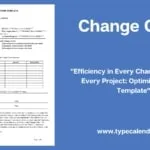Describing how a program really makes a difference is much more than listing budget items or activities. A properly constructed Theory of Change (ToC) combines the problem, assumptions, cause–effect chain and how you will measure success into a single framework. So, from donor submission to the field team’s daily decision, everyone sees the same story on the same diagram.
Focusing on this need, TypeCalendar has developed more than 39 Theory of Change Templates prepared for different contexts, from NGOs to public programs, from social enterprises to corporate impact initiatives. Each is an individual download; the goal is to turn a tangle of ideas into a clear roadmap.
Table of Contents
The Story That Solves the Problem: “Why, for Whom, and How?”

Our ToC templates start with the intended change statement, not the list of activities. We first note root causes, beneficiary groups, and the desired behavior/outcome-level change; then we answer “Why will this solution work?” with short, testable hypotheses. Thus, the diagram is not just a poster it is a defensible narrative.
TypeCalendar’s 39+ Theory of Change Templates
The collection solves the problem of “one size does not fit all” because it is layered according to the intended use. Separate folders include: one-page canvases for field workshops; poster-size, board-ready diagrams; narrative-plus-diagram packages for grant applications; M&E-aligned indicator registers; and designs that illustrate nonlinear impact pathways (e.g., policy advocacy and systems change). Dedicated tracks cover education, health, livelihoods/employment, climate/environment, gender, digital product/edtech, and humanitarian contexts; you download only what you need.
Formats and Canvases
- PPTX / Google Slides: Grid canvas for collaborative production and workshop; box/arrow drag-and-drop, easy revision.
- Miro / Mural canvases: Simultaneous writing, versioning, quick clustering with “sticky” notes.
- DOCX/Google Docs: copy-ready short ToC paragraph skeletons for grant applications.
- XLSX/Google Sheets: indicator registers with baseline, target, source, frequency, and disaggregation fields, plus a data-collection schedule.
- PNG/PDF outputs: high-resolution images for embedding in reports and management presentations at full resolution.
Logical Chain: Inputs → Activities → Outputs → Outcomes →Impact
The core of the templates is to establish causality clearly and visually. After the resources (human, budget, partnerships) are clarified, the activities are written down; however, the flow does not stop at the output. It extends from short-term results, which are attributed to each output, behavior or change in situation, to the intermediate term and finally to the impact level.
The arrows are not just a line: each connection has small note fields for the assumption (why do we think it will happen this way?) and the evidence strength (publication, previous pilot, literature). Thus, the diagram goes beyond the visual of the presentation and becomes the evidence file of the reasoning.
Indicators, Baselines, and Targets
The language of impact is quantitative. Our ToC templates include a dedicated register for SMART indicators linked to outcome nodes. The base value, target, data source, measurement frequency and parsing (gender/age/location) fields are added to each indicator; the data collection method and calculation formula are briefly noted.
Instead of saying “school absenteeism will decrease”, you speak in unquestionable terms such as “absenteeism rate %18 → %10 (12 months, administrative record). Placeholders for learning questions and interim hypotheses keep the evaluation cycle in line with the plan.
Download, Map, and Accelerate Learning
Make your project not only work, but also show why it works. Choose the template that fits your context from TypeCalendar’s 39+ Theory of Change Template set, map out your impact pathway, flag evidence gaps and connect indicators. At the first meeting, the team discusses the same story; in the first report, you present an outcome narrative to the donor—not just a cause–effect chain. Download today, tomorrow move your decisions from assumptions to evidence, from activities to impact.








































![%100 Free Hoodie Templates [Printable] +PDF 1 Hoodie Template](https://www.typecalendar.com/wp-content/uploads/2023/05/Hoodie-Template-1-150x150.jpg)
![Free Printable Food Diary Templates [Word, Excel, PDF] 2 Food Diary](https://www.typecalendar.com/wp-content/uploads/2023/05/Food-Diary-1-150x150.jpg 150w, https://www.typecalendar.com/wp-content/uploads/2023/05/Food-Diary-1-1200x1200.jpg 1200w)

